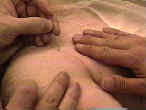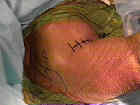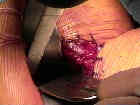- See:
- Arthroscopic Reconstruction
- Historic Operations
- Revision Bankart Procedure
- Bankart Repair:
- reattachment of the capsule and glenoid labrum to the glenoid lip;
- subscapularis is carefully divided to expose the capsule, and is reapproximated without any overlap or shortening;
- PreOp Eval:

- rotatory stress test for anterior instability;
- indentify any multidirectional instability, or bony defects of the glenoid or the humeral head; (Hill Sachs Lesion);
- Axillary Approach:
- identification of the musculocutaneous nerve
- identification of the axillary nerve
- transection of the subscapularis
- caspsular transection:
- external rotation of the humerus affords better capsular exposure and relaxes the nerve;
- insert a blunt retractor inferiorly to protect axillary n, insert skin hooks to elevate the capsule superiorly and place it under tension;
- vertically transect the capsule at a point midway between the lesser trochanter and the edgle of the glenoid;
- carry this vertical capsular incision superiorly into the rotator interval, which converts the capsular incision into a T (since
the rotator interval lies in a horizontal direction);
- at the end of the case, the superior and inferior capsular capsular flaps are closed (and shortened) in order to shift the inferior capsule in a superior direction;
- the vertical portion of the incision is closed anatomically (so that there will be no loss of external rotation);
- Management of Bankhart Lesion:
- articular exposure:
- in a minority of patients, loose bodies will be present;







- bankhart lesion assessment:
- a joker or similar instrument may be placed into the defect, which places the labrum under tension and allows assessment of its length;
- it is controversial as to whether labral tears less than 0.5 mm to 1 cm need to be repaired;
- if the Bankhart lesion is large enough for repair, freshen the underlying sclerotic bony surface with a rasp or burr;
- if a Bankhart lesion is not present, then consider whether the patient has a Hagel lesion (capsular avulsion from the proximal humerus);
- bankart lesion fixation techniques:
- note that in patients undergoing anterior shoulder reconstruction for anterior instability, the finding of a normal labrum should alert the
surgeon to the possibility of a HAGL lesion (humeral avulsion of the glenohumeral ligament);
- in patients that present with anteiror instability due to trauma, the prevelence of a HAGL lesion may be as high as 39%;
- the HAGL lesion is typically found below the level of the subscapularis in the inferior pouch of the shoulder;
- ref: Anterior instability of the glenohumeral joint with humeral avusion of the glenohumeral ligament. A review of 41 cases.
- Capsular Repair:
- based on the preoperative exam and operative findings, the surgeon will determine the relative need for a superior shift of the inferior capsule
and/or a medial-lateral capsular imbrication;
- the arm is positioned in 20-25 deg of external rotation and abduction;
- horizontal matress sutures are inserted into the medial half of the capsular edge but are not yet passed into the lateral capsular leaf;
- a vertical shift of the capsule is effected by inserting a purse string stitch through the superior leaves of the transected capsule and the superior
coraco-humeral ligamentos (or the CA ligament if the coraco-humeral ligaments are deficient);
- a more superior shift is effected by incorporating a deeper purse string stitch into each half of the capsule;
- imbricate the medial half of the capsule underneath the lateral half of the capsule using horizontal matress sutures;
- avoid over tightening of the rotator interval:
- Bigliani LU et al (AOA annual meeting 1999), 16 patients required revision shoulder reconstruction following overtightening of rotator interval;
- all patients noted stiffness and antero-inferior instability following tight closure of the rotator interval;
- references:
- Loss of external rotation following anterior capsulorrhaphy of the shoulder.
- Isolated closure of the rotator interval defects for shoulder instability.
- Repair of Subscapularis:
- it is essential that the subscapularis be securely repaired, since postoperative ruptures do occur and result in disastrous consequences;
- if necessary an addition suture anchor can be placed in the proximal humeral to augment the repair;
- it is also essential that sutures are not pass thru the biceps tendon, since this will produce a painful biceps tendinitis;
- ref: Open Bankart repair: correlation of results with postoperative subscapularis function.
- Post Op Care:
- range of motion restrictions:
- ER to 0 deg at 0 deg abduction;
- elevation to 90 deg in the scapular plane;
- internal rotation to L1;
- aquatic therapy: range of motion is encouraged as long as the shoulder is submerged
- Complications
- Loss of External Rotation:
- possible etiologies:
- over-tightening of the capsule;
- obliteration of the sub-deltoid and sub-acromial space
- contracture of the coraco-acromial ligament
- contracture of the rotator interval
- scarring of the subscapularis on the shoulder capsule
- contracture of the subscapularis;
- preoperative considerations:
- patients may be encouraged to undergo physical therapy, however, many surgeon's are pessimistic about the ability of nonoperative
therapy to improve ROM (in this particular situation);
- amount of external rotation:
- less than 0 deg of external rotation: proceed with surgery;
- between 0 deg and 30 deg: consider surgical release based on symptoms;
- more than 30 deg of external rotation: surgery can be avoided in most cases;
- treatment:
- arthroscopic release:
- prior to performing capsular release, ensure that the subscapular tendon is well demarcated (inorder to avoid transecting the tendon) and
to demarcate the 5 o'clock position of the capsule (below which lies the axillary nerve);
- scarring may distort the usual features of these structures;
- damage to the axillary nerve is minized by keeping the arm in adduction during the release;
- anterior capsule is released at a point just inferior to the biceps tendon and is continued to the inferior edge of the glenoid;
- release of the rotator interval and coracohumeral ligament is especially important for patients who have loss of ER in adduction;
- following capsular release, attempt a gentle closed manipulation;
- open release:
- indicated for failure of arthroscopic release to improve motion;
- z plasty lengthening of the subscapularis and anterior capsule;
- alternatively the subscapularis can be reattached to the anatomic neck of the humerus which places it medial to its anatomic insertion;
- references:
Loss of external rotation following anterior capsulorrhaphy of the shoulder. Release of the subscapularis
Release of the subscapularis for internal rotation contracture and pain after anterior repair for recurrent anterior dislocation of the shoulder.
Arthroscopic release of postoperative capsular contracture of the shoulder.
Bankart repair for anterior instability of the shoulder. Long term outcome.
The capsular imbrication procedure for recurrent anterior instability of the shoulder.
An approach to the repair of avulsion of the glenohumeral ligaments in the management of traumatic anterior glenohumeral instability.
Anterior fracture-dislocations of the shoulder: pitfalls in treatment.
Failed surgery for recurrent dislocations of the shoulder.
Failed anterior reconstruction for shoulder instability.
Recurrent anterior dislocation of the shoulder after surgical repair. Apparent causes of failure and treatment.
Instability of the shoulder: Complex problems and failed repairs. Part II. Failed Repairs.
Open surgical treatment of anterior glenohumeral instability: an historical perspective and review of the literature. Part II.

